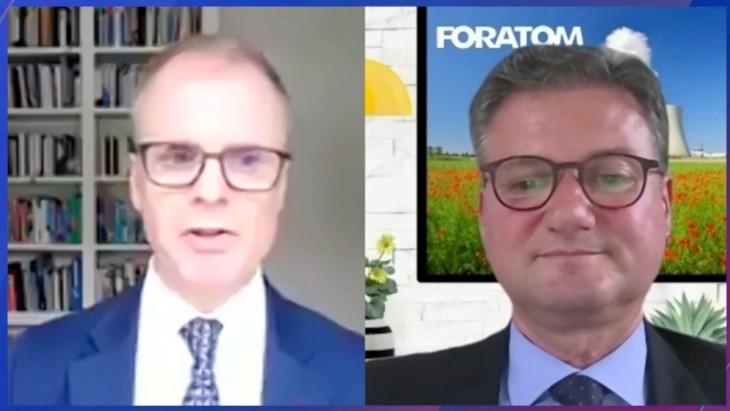Speaking from the COP26 climate change talks in Glasgow, Scotland, Foratom's Communications and EU Stakeholder Director Jessica Johnson said, "This year, nuclear is a topic for an open discussion. People are coming to us and asking relevant questions. We are not being confronted. This time people want to know more about nuclear and this time they are are willing to consider it." She added that she has not seen conversations like this at a COP event for ten years.
Foratom Director General Yves Desbazeille related this to the high gas prices Europe in particular is currently facing. "A gas shock is turning into an electricity shock," he said. "We need low-carbon sources, and we also need dispatchable low-carbon sources. This is where nuclear is in everyone's mind. It has come back in the debate, nationally and at the EU level."
The comments were made today in a Moody's webinar entitled What are the prospects for new nuclear in Europe?
The reasons for the gas issue have been a growing reliance on the fuel to back up renewables, while regional production has slowly declined, said Desbazeille. It is exacerbated by a high price for carbon dioxide emissions in the EU Emissions Trading Scheme of about EUR60 (USD70) per tonne. "In a way [a strong carbon price] is good news because it gives a clear signal to economic players that, yes, gas comes with a price and everyone should try to find solutions to the issue," said Desbazeille.
Because of this, the political landscape is starting to change slightly, Desbazeille said. "There are heated debates on the taxonomy and it has become in a way a very entrenched debate between countries which support nuclear in the taxonomy and the others who do not." But, he said, "There is some positive evolution. More and more EU member states are taking very supportive positions on inclusion of nuclear, including some who have remained relatively silent in the past." Desbazeille and Johnson mentioned the Netherlands, Greece and Sweden among the newly vocal supporters of nuclear, in addition to a group of nine other countries led by France.
And in the European Commission, "this has consequences," said Desbazeille. "Some commissioners are taking positive attitudes on nuclear whereas in the past they remained very silent."
Foratom said it expects the European Commission to issue a Delegated Act to settle the matter of nuclear in the taxonomy by the end of this month. Johnson said: "The science is clear. Nuclear is low-carbon and nuclear is sustainable. If [the European Commission] wants the taxonomy to be credible they need a scientific approach. They cannot have a political approach because it will discourage investors from using it."
The taxonomy is particularly important for the future of EU nuclear because it will unlock a new source of more affordable investment for nuclear, as well as setting a positive precedent for future EU policy.
Financing options
Speaking on the same webinar, Joe Rippen, EDF Energy's financing programme manager for the forthcoming Sizewell C plant, explained the power of financing options to lower nuclear construction costs.
The UK's only current construction project, Hinkley Point C has an agreed strike price of GBP92.50 (USD126) per MWh in 2012 prices, said Rippen. Of that cost, only GBP11-12 is for construction, about GBP20 is for operation and the rest is the cost of finance, he said. At an interest rate of 9%, "About two-thirds of the cost of Hinkley Point C is to meet financing costs. At about 6% the strike price would have been below GBP60," he said.
One of the keys to reducing these costs is firstly to master construction by learning lessons from past projects. Rippen pointed out that Sizewell C is to be largely a replica of Hinkley Point C, which itself was able to learn from EPR construction at Olkiluoto in Finland, Flamanville in France and Taishan in China. Secondly, Rippen welcomed the Regulated Asset Base legislation introduced by the UK government recently as "a major step forward." It will enable "greater risk sharing between investors and consumers," he said, "and the same applies to financing and operating costs."
.jpg)
Sizewell C buildings shown in green will be identical to their counterparts at Hinkley Point C (Image: EDF Energy)
EDF Energy, which is driving the Sizewell C project, is a subsidiary of France's EDF. It has decided that "Sizewell C needs to be an independent and standalone company," said Rippen. "EDF wants a minority stake. We need to find finance - equity and debt - from third parties. We have to get over the construction risks and find a way to get over the absence of revenue during construction."
Many such new build projects could be needed in the EU, for its member states to reach their common target of net-zero in 2050, which has an intermediate step of a 55% reduction in emissions by 2030, dubbed 'Fit for 55'.
Desbazeille said that Foratom modelling shows successful long-term operation of current nuclear power plants in the EU would save "nearly 200 million tonnes of CO2 equivalent by 2030" compared with currently announced plans by EU governments. He showed a 'high nuclear scenario' in which nuclear maintains its 25% share of EU electricity, while the power sector as a whole grows by 60% to 2050. To achieve this demands 80 GWe of new nuclear capacity - "a very ambitious number", he said.
"If we want success we have to build new capacity now," said Desbazeille. "80 GWe is the same order of magnitude as what was done in the late 1970s and 1980s - a full nuclear programme that needs to be implemented."





_47120.jpg)

_23621.jpg)






